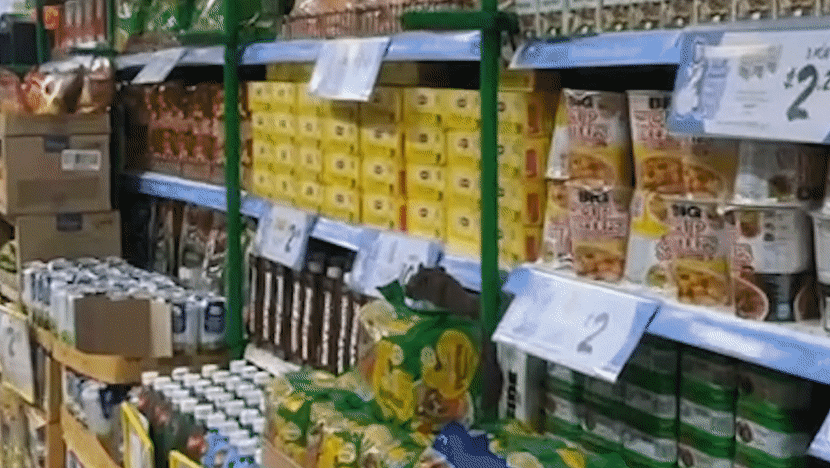Rats are a growing problem in Singapore. Here are the hotspots and what’s being done
Toa Payoh, Tampines and Hougang are the areas with the most rat sightings, according to reports CNA Insider and the programme Talking Point received from readers and viewers across the island.
.png?itok=kKiQ62HA)
Viewers across Singapore reported rat sightings in their estates — and even their homes for some. (Image: WhatsApp/Eng Jeng Hwee, YB, Wubi Goh)

This audio is generated by an AI tool.
SINGAPORE: Twice recently, as Shantel Lim was jogging near her home, she got quite a shock when a rat scuttled past in front of her.
Besides the shock, she felt a little anxious about being bitten. “I’d have to go to hospital immediately, as (rats) carry many pathogens, viruses … and bacteria,” said the 24-year-old.
It is not just the solitary rat or two, however, that she has chanced upon in her Tampines Street 33 estate. She sees them in the void deck, “always at rubbish chutes” and in drains too.
Recalling an instance where she saw five rats, she said: “They were really big and making loud squeaking sounds.”
She has even seen up to eight rats in a pack, creating a situation she described as “unsanitary, dangerous and disgusting”.
“It’s a big problem in Tampines because it’s not only me who’s experienced this. My friend who lives nearby said rats are a common sighting around her block as well,” she said.

Now, more than ever, she is convinced that the rodent issue needs addressing — after CNA Insider and the programme Talking Point asked readers and viewers across Singapore to report their rat sightings to us via Instagram, WhatsApp, email and TikTok.
Within 10 days, we received 320 reports, including photos and videos. The places shown included playgrounds, lift lobbies and even supermarkets. These were collated to create a rat map, showing which areas may be having it worse than others.
Tampines was indeed one of the top three hotspots, with 42 sightings out of 503 map entries in total. First on the list, however, was Toa Payoh, with 54 sightings. The third town was Hougang, with 25 sightings.
Talking Point investigates just how pervasive Singapore’s rat problem is, plus what is being done about it, in a two-part special.
TOWN COUNCILS RESPOND
The town councils managing the three abovementioned estates all said they were monitoring rat activities or had surveillance operations in place. And they highlighted that they are working with various parties including the National Environment Agency (NEA) to address the issue.
“We also take a holistic approach, enlisting co-operation from food outlets, supermarket operators, members of the community, and authorities managing construction sites for infrastructure projects to keep our estate and public spaces clean,” said Tampines Town Council.
“To tackle the rat issue effectively, there must be consistent efforts by all parties.”
Arising from these efforts, along with a “comprehensive and sustained rat surveillance and control programme” it has implemented with the NEA, there have been “positive results in the reduction of rats’ activities”, added the town council.

Over in Toa Payoh, where Bishan-Toa Payoh Town Council (BTPTC) has engaged professional pest control services, surveillance and culling operations have been stepped up since January.
“At places where rodent burrows are detected persistently, ground treatment is done almost daily, and culling operations are conducted at least every fortnight,” said BTPTC chairperson Chong Kee Hiong in reply to our queries.
“Ground treatment” refers to the process of putting baits into the burrows continuously to “eradicate the rats”, before sealing inactive burrows. The same process is repeated for active or new burrows.
Culling exercises are also conducted at night. This includes placing cage traps at strategic locations, such as bin chutes, central refuse chutes and bin centres.

“Concurrently, the town council is seeking the co-operation of nearby coffee shops and hawker centres on proper food waste management so as to curb potential food sources for the rodents,” said Chong.
Inspection and enforcement operations at Toa Payoh’s food outlets are done in collaboration with the NEA and the Singapore Food Agency (SFA), and BTPTC will “seek out new or improved methods to address the rodent issue” going forward.
“We also intend to assist residential units on the ground floor to keep rodents out,” said Chong. “The town council is committed to keeping our estate clean and safe for our residents.”
Aljunied-Hougang Town Council (AHTC) echoed the other town councils in its reply and said that “in the light of the current trend of rodent sightings across Singapore”, it conducts “thorough site investigations to identify the underlying causes”.

“Our investigative process includes … identifying potential sources of portable food, assessing the storage of bulky waste that may create conducive environments for harbouring rodents and determining the species of rodents present to implement effective trapping strategies tailored to their habitats,” it said.
“There’s added vigilance in localities where there are major construction works going on, such as the Cross Island Line tunnelling works in Hougang, as rats are forced out of their harbouring areas.”
AHTC also “undertakes educational outreach” to encourage proper disposal of food waste, such as “securely bagging leftover food and disposing of it into and not beside rubbish bins”; not leaving behind food consumed in common areas or leaving food unattended; and not feeding birds.
“Such indiscriminate disposal of food waste could potentially cause rats to multiply rapidly,” said the town council.

AHTC cautioned, however, against use of the term “rat infestation” as it “implies a surge in rat population, which may not necessarily be the case in every instance of (rats being sighted) but which causes undue public alarm”.
15 RATS CAUGHT IN A DAY
Yet, some Singaporeans, such as Toa Payoh resident Eugenia Tan, suspect that there may indeed be “a problem of rat infestation” in their estates.
The fresh graduate said “the rate of seeing those rats” has gone up as the years have gone by. “It might be too big a problem, especially because they reproduce quite fast,” the 23-year-old added.
According to Martha Lee, her father — having observed rats in a community garden near Toa Payoh Polyclinic — took matters into his own hands and once caught 15 rats in one day. He caught more than 80 rats altogether, she said.
WATCH PART 1: Rat infestations in Singapore — Where are they hiding? (22:58)
Some members of the public have even spotted rats among supermarket shelves, and not just lurking outside the premises.
CNA’s rat map includes images of the rodents in Giant, for example, and parent company DFI Retail Group responded by saying the health and safety of its customers was “a top priority”.
“Upon being alerted about the pest sightings, we immediately initiated thorough sanitisation of the area and increased the frequency of inspections by the pest control team,” said a spokesperson.
“In vicinities experiencing frequent pest sightings, we’ve intensified our co-operation with the local town council. For instance, our team at Giant Ubi Avenue 1, along with other neighbouring shop owners, have been working very closely with the Marine Parade Town Council as a united front to address this environmental concern.”

CNA’s rat map also included sightings at Jurong West Stadium and Clementi Sport Centre, which led Sport Singapore (SportSG) to ramp up pest control efforts at both ActiveSG facilities.
“ActiveSG Sport Champions have also been reminded to stay vigilant and practise preventive measures as part of day-to-day operations,” said SportSG.
“These include ensuring cleanliness, minimising the presence of food on site and sealing any gaps or cracks that may be present in walls, doors, windows or the ground.”
For the NEA, keeping the incidence of vector-borne diseases low “remains a priority”, it said in March when the Ministry of Sustainability and the Environment designated 2024 as the year of public hygiene.
WATCH PART 2: Singapore’s war on rats — Can these rat-busting solutions work? (22:01)
This year, the NEA will “focus on tackling rat issues at source” by, for example, stepping up enforcement — with the SFA — of waste management at food premises and bin centres.
In addition, the NEA and Enterprise Singapore are working with the Singapore Pest Management Association to develop a new Singapore Standard for performance measurement in the pest management sector.
More recently, a trial of thermal imaging cameras to detect rats began in April. It will enable better rat surveillance at outdoor and back-lane areas, the NEA said. The trial will last four months.
Based on figures from NEA surveillance, rats are a bigger problem than before.
In the pandemic years of 2020 and 2021, there were, on average, 4,300 and 3,900 rat burrows detected in public areas, respectively, in each two-month surveillance cycle.
In 2022, an average of 4,163 rat burrows were detected in public areas per two-monthly cycle. Last year, the figure rose to 5,203, which is higher than the pre-pandemic number of 4,740 in 2019.
What disappoints 34-year-old Jordan Poh is that his Build-To-Order project, Tampines GreenFoliage, was completed two years ago, yet he has spotted rats on “multiple” occasions, including in the multi-storey car park’s rooftop garden.
Over in 376C Hougang Street 32, local resident Sue, who declined to give her full name, has recently been seeing “a large population of rats” almost daily. But she is sanguine about it.
“I don’t know enough about rat management to … know if this is a big problem,” she said.
“I do find it amusing that there are so many rats in the estate when we also have quite a population of cats. Clearly, these cats aren’t hunters.”
Watch the first episode of this Talking Point special here and the second here. The programme airs on Channel 5 every Thursday at 9:30 p.m.


















